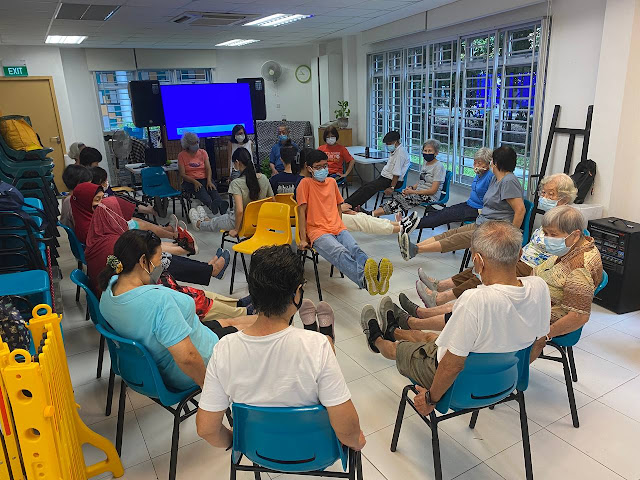In a team of five, my group and I conducted a 4-week community dance programme with around 20 seniors at the Anglican Senior Centre (Woodlands). It was part of a Design-Your-Own-Module led by Yarra Ileto, Artistic Director of contemporary dance group, NUS Dance Synergy. The community sessions were conducted after 6 weeks of tutorials on body mechanics and explorations on how to conduct a community dance session.
The 1h 30min sessions included: a warm-up game; conditioning exercises and teaching of a choreographed dance. Yarra had provided the first dance to the theme of "Nature" for the first two weeks. And my group and I did a second dance to the theme of "Going to the Disco" for the last two weeks.
LEARNING POINTS
I had to make great strides in learning how to do dance with community members. This was especially difficult given my limited dance background. So, learning to lead dance in a scaffolded and engaging way and incorporating conditioning exercises was where my personal learning curve was.
Our sessions with Yarra were more instructive about safety. For example, being careful about having dance moves above seniors' head. It showed me that there was more to learn about safe dance practices and I had more to learn in order to independently evaluate whether a movement is safe for seniors. In the meantime, we emphasised to the seniors to do the best they can and it was ok if they were not able to or if they needed a break.
Some community members were also less mobile. While Yarra had prepared us to have seated and non-seated elements in the dance, I thought the team was quick in modifying the conditioning exercises to a seated version. That is something I wish to be able to do more quickly - to be more acquainted with my body, be able to adapt a movement such that I am still engaging the same muscles in a different position.
There was much to learn about the diverse cultural background of community members. There were some initial trouble with language as we didn't quite know how to lead in Malay - leading exercises in Mandarin was tough enough! A certain level of literacy was needed in order to engage seniors creatively when we incorporated imagery or storytelling to the movements. However, the community members were also quick to translate for each other out as they warmed up to each other over the weeks.
One important reminder that happened during the sessions was about how cultural background might affect the sessions. We had initially wanted to have all the seniors who were less mobile to sit together so they could do a seated version of the dance. However, one of the community members let me know that a gentleman was not comfortable with seating next to someone of the opposite gender. And so, we adapted by having seated dances at 2 parts of the room.
This did make me nervous especially our team's theme was on "Going to the Disco". Would it have been too "out there" or inappropriate? However, I was glad that we took a leap of faith and continued on. There might have been some safety in it being "make believe" and the participants did chime quite excitedly about how they have never been to a disco before.
In conclusion, this experience opened my eyes to elements in conducting an inclusive dance-centric community session. It reminded me about the impact of cultural differences on the session and pointed me to new areas of knowledge I could learn such as: body mechanics and safe dance practices.

